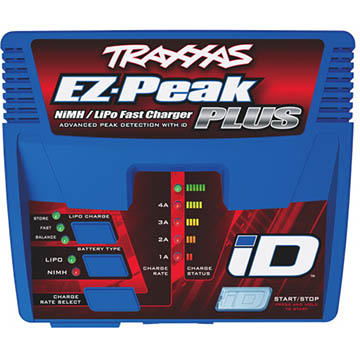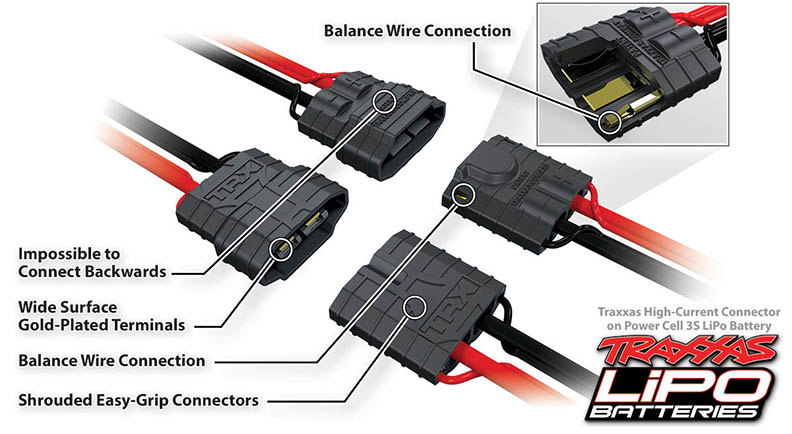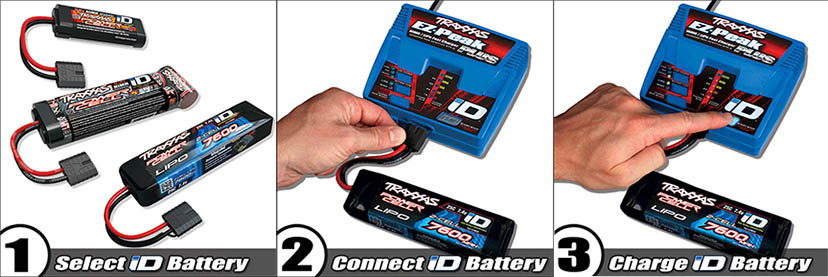
The world of RC vehicles is a very fun place to be. Powerful scale model versions of your favorite real world racers are fully equipped to handle serious terrain; and they’re a lot of fun. That is, they’re a lot of fun when they’re full of power and ready to go, without the fully charged powercells, well, they’re just an exceptionally well designed, aggressive looking model car. Taking the confusion out of keeping your Traxxas vehicles full of juice and ready to go is the new Traxxas iD system. Streamlined and full proof, with their new power cells (batteries) and EZ-Peak Plus Charger, they’ve taken the challenge out of charging.
More Power
They say a chain is only as strong as its weakest link, an analogy that has certainly been true in my experiences with the world of RC vehicles. A marvel of engineering, you get a 1/10th scale model of a 4 wheel drive beast machine, including independent suspension, racing differentials, water proofed wiring to make it go fast in tough places. All this amounting to a vehicle so cool looking, it makes you grin like you’re about to do something against the rules, and it can reach top speeds of up to 100 km/hour. Awesome right? Now imagine looking at all that promise, that sleek, aggressive machine sitting at the entrance to a gravel lined, obstacle filled, hilly slice of RC testing heaven. It makes a person feel pretty good, giddy even. Right up until the moment you realize the batteries didn’t charge properly, and now you have to carry this incredible machine, whose entire existence is about going places fast, all the way back home.
Oh the irony. It doesn’t matter how boss the vehicle is, without a reliable power source, it’s just an oversized hot wheels car. I had two of them with me, and a friend along for the fun, on that day when this happened to mean: I had absolutely no idea what went wrong. Needless to say, charging the power packs has always been a little bit confusing. Luckily the folks at Traxxas, no doubt in response to experiences just like mine, revisited their battery systems, streamlining the whole affair to make it easier for folks like you and me. The good news? They succeeded, with their new Traxxas iD power cells, and EZ-Peak Plus Charger.
One look at the charger, without even cracking the instructions (which was a double sided single paged info graphic … another good sign) I could see immediately that the system had been vastly improved. Previously, the charger was less user friendly, more like something located in the basement of some Junior Dr Frankenstein character, with wires all over the place, and just enough of a read out display to be confusing. The onus was on you, (or in this case, me) the “consumer,” to know what sort of battery you had (there are many options) and the rate at which it should be charged, as well as the amperage. Once you got through all of that, it wasn’t super clear on whether or not the charger was doing what it was supposed to. Luckily back then the customer support, both in the community forum threads, and in detailed documentation (paperwork, instructions) online, helped me. Best believe I was ready and willing to call the help line, but it didn’t come to that. And now, with their new ID system, it never will.

ID please
As indicated by the clever name, the beauty of the new charger is that it does the work for you. It’s a one size fits all, charging both the NiMH (Nickel-Metal Hydride) and LiPo (Lithium Polymer) in all their many configurations. If you’re curious about the difference between the two, NiMH batteries are the standard variety, and definitely the go to for your average user. LiPo batteries are more high performance, but also more high maintenance. Not all vehicles can use them, and those that can require “low-voltage detection” capable electronics, because these things pack a lot of juice. Put simply, if you don’t fully know the difference, stick with NiMH, as the LiPo varieties are preferred by the more rabid enthusiast, looking to max out acceleration and top speed, particularly for racing against other hardcores enthusiasts.
Regardless of the power source you’re charging, the new charger “Identifies” that battery type, and narrows down your options to a few button presses. It also has the benefit of running of a wall socket, rather than the aux power (cigarette lighter) of your car, like many of their other chargers. The system has also brought their various power cells together under their new, redesigned Traxxas iD ‘High-Current Connector’ end. The high-current connector makes much more sense visually, and is, as they put it ‘impossible to connect backwards’. Having been the guy scratching his head wondering ‘am I doing this wrong?’ the assurance is welcome. With gold plated copper terminals, wide connection surface and heat shrink tubing, The new Traxxas High-Current Connector was re-engineered to provide almost zero resistance, so more power goes straight to the bits that make it go fast. It was very intuitive, simply plugging the battery unit identified the battery type, narrowing down the options from there considerably.

The large, glowing blue button, which practically begs you to press it, is all that stands between you and a charged battery. Well, that, and time (under an hour’s charge). It’s slightly more complicated with the LiPo batteries than the NiMH, having 3 charge options, Fast, Storage, and Balanced, the latter being the default. “Balanced” is also the recommended setting, and frankly, when the charge rate comes in under an hour, I’m not sure why you’d need anything else. Holding down the very bright glowing blue button started the charge indicated by the flashing green light which, when it was done, turned solid. The included info-graphic instructions (instructions with pictures) was bright, and glossy, easy to read, answering what few questions I had in a moment. Alternatively, the instructions are available online. As well as a series 3, 7 Cell Nimh, I got the 2 cell LiPo, and a Series 1 1200mah NiMH (smaller pack for the 1/18th scale units). Unlike my previous experiences charging power cells, the process was essentially identical (save the small LiPo caveat above) Having been the fool previously, I can say this is pretty much foolproof.
Overall
Navigating this very crucial aspect of their vehicles use to be a source of confusion, and frankly, made me cringe. Only the fact I had a review due, and the promise of fun times with powerful Traxxas RC vehicles made me follow through. The new Traxxas iD power cells, and EZ-Peak Plus Charger Traxxas have revisited, redesigned and vastly improved all aspects of navigating the power source, which is at the heart of the RC, both literally and figuratively. This new system makes it all easier, streamlining the process across the wide variety of power cell products they make. With their new connector ends, a one (possibly two) button charger that does most of the work (and thinking) for you, and an easy to follow, glossy, full color, image-based instruction doing the rest, Traxxas has taken the bite out of that dreaded middle step. The step between getting the box with the really fun toy inside, to actually using that vehicle with a grin on your face. Ultimately it all adds up to a vastly improved consumer confidence and removing the barrier to entry, which can stand in the way of someone with a more casual interest.
After spending time with five of their products, I was already a fan of Traxxas and their take on the RC vehicle, this improvement (and my recent experiences with the Traxxas Slash and Latrax SST, they certainly helped too) may have been the push that sent me from casual fan, plummeting into depths of “RC enthusiast.”
Sign me up, because this stuff is just plain fun.
Overal Rating 5/5



